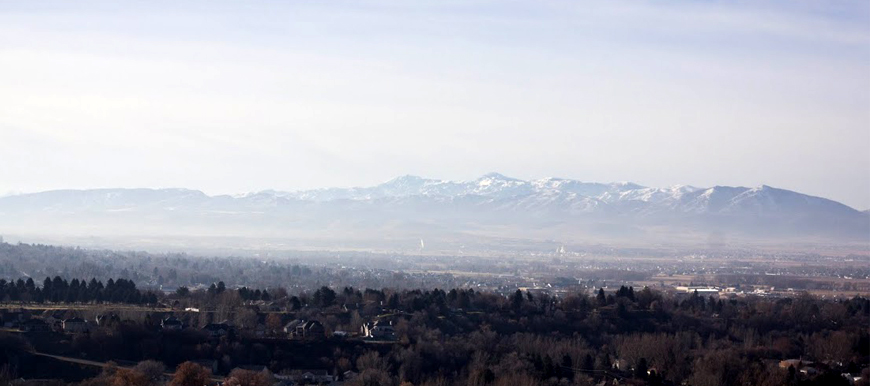Is there a silver lining of the COVID-19 pandemic? Environmental experts say maybe
After weeks of isolation and economic loss resulting from businesses shutting down around Cache Valley, there may be a silver lining in the form of decreasing air pollutants.
Awbrey Burgess, a senior at Utah State University studying geography, said this situation shows air pollution can be mitigated through self-awareness.
“The earth is getting a break right now,” Burgess said. “Moving forward, we should be thinking about how to balance the economy with the environment. Doing simple things like walking more and not driving a car everywhere.”
Northern Utah is notorious for poor air quality.
Randal Martin, the division head of environmental at USU, co-authored an article in Jan. 2016, where he wrote that, throughout the last 15 years, Cache Valley has generally exceeded the recommended 17 poor air quality days per year recommended by the Environmental Protection Agency.
According to Martin, while Cache Valley has been doing better with pollution since 2016 because of regulation on businesses, there is still a problem with inversion.
Inversion is the result of a bowl structure. Most of Utah’s population lives along the Wasatch Front, surrounded by mountains on all sides, creating a “bowl.” During the winter cold air is trapped in the valley, which, according to Martin, causes everyone to “swim in their own soup,” or constantly breathe in pollutants stuck in the valley.
“Because winter is over, it’s going to be difficult to see if the effects of coronavirus have any impact on inversion,” he said, “however, it does impact us significantly in other ways.”
Martin says the Utah Department of Transportation has reported a 25-30 percent reduction statewide in emissions since people started staying home. Also, the state previously implemented restrictions to reduce overall pollution by requiring 1.6 tons less of pollutants be emitted in the air every day. However, because people are staying at home and not traveling, Martin said, we are now doing 3.1 tons less of pollutants per day.
“Basically, we are currently doing almost twice what the state requires of us,” he said.
In terms of how this will impact Cache Valley long term, Martin said it’s too soon to tell, but, if shutdowns continue into summer, we could see reduced concentrations of ozone.While the ozone layer acts as a shield for earth, direct contact with “ground-level” ozone is bad for plants, animals and humans.
According to the EPA, exposure to ozone levels of greater than 70 parts per billion for 8 hours or longer is unhealthy. Cache Valley, Martin said, generally “bumps right up against that number.” He added having people stay inside when they are generally traveling during summer months will tell us a lot about how driving habits impact the ozone layer.
Blair Larsen, a Geoscience Education professor at USU, agrees there may be positive effects on the environment because of the virus.
“Air pollution and industrial emissions are down for a number of sectors, which leads to better air quality and overall public health,” Larsen said. “At the same time, the pandemic is forcing people to focus on the benefits of their local recreation opportunities, which in general is probably a good thing.”
Larsen did say, however, the positive effects of the COVID-19 crisis should not mitigate the negative ones.
“As with most things, if people pause to think a bit more before they take action, then we can decrease the negative effects and increase the positive effects,” she said. “For example, as we spend time hiking nearby trails, we can appreciate their beauty and resolve to maintain them better in the future.”
Despite the good that may come to Cache Valley from better air quality, Martin said he “certainly doesn’t want to pin a rose on the situation.”
“We need to look at silver linings, and the silver lining here is we have proof that driving is a major problem for the environment.”
He added the main thing we should take from this is how to balance economic interest with environmental interests.
“If we can learn to drive less and balance this out, it will be a good thing going forward.”
Burgess also had a message for her fellow college students: once life gets back to normal, be careful.
“People are already talking about road trips and all the fun plans they have to drive everywhere once the crisis is past,” she said. “We can’t go crazy or else we will be right back where we started.”
@cripe_taylor

